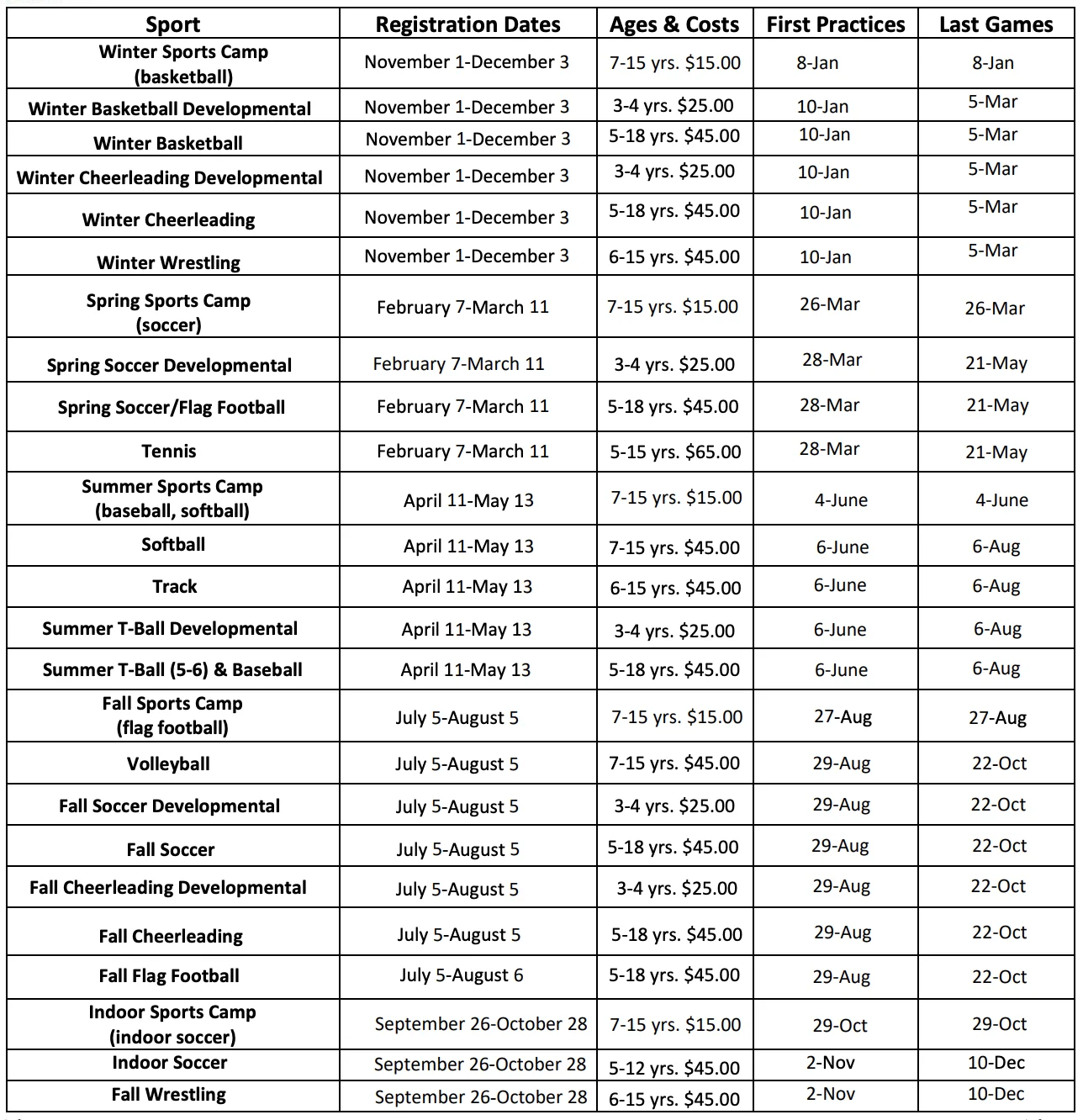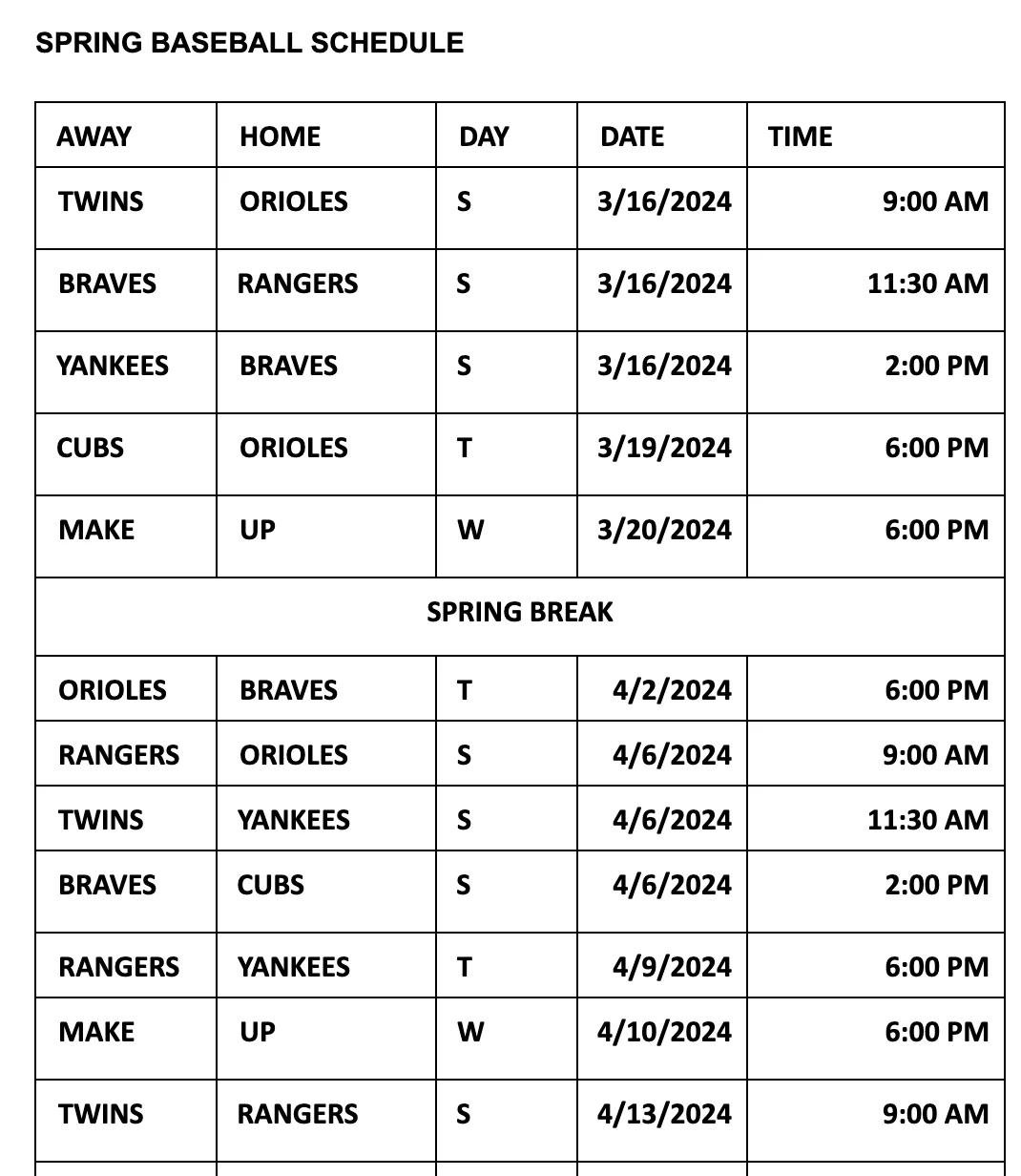
Planning your youth sports calendar is an art form in itself. You must find the perfect start and end dates, work around local school holidays, balance practices and game time, and do everything else in between.
That’s why we’ve put together this guide—to help you find all the answers that make putting your youth sports calendar together as easy as possible.
Read on to learn more about effective scheduling, planning, and execution, plus find an example of an existing youth sports calendar to inspire yours.

How to make an effective youth sports calendar
As we mentioned, effective scheduling is an art form. Understanding the basics can help you build the right foundation for your youth sports calendar.
1. Plan in advance
First things first, you need to consider your sports calendar well in advance. If your youth sports organization only runs a single sports league, think ahead of time about when your league will run so that it doesn’t run into major holidays or coincide with other sports.
For example, winter basketball leagues will need to consider the winter holidays in their calendar planning to ensure no special events are missed.
Planning out your calendar is not a last-minute affair. Plan at least a year in advance to ensure your league’s timing is as conducive to widespread participation as possible. This helps you set up things like sports registration dates, facility or equipment rentals, practice and game schedules, and other key fundamentals.
2. Balance the calendar
One major component of getting your calendar right is balancing all of the different teams, divisions, and competitions so nothing overlaps. Account for each of your teams so they have enough games, facilities are available, and practice times don’t run into each other.
3. Check facility availability
Facility availability is one of the most important parts of building a calendar—especially if your youth sports league shares facilities with other organizations or recreational activities. In fact, your entire schedule will rely on when your facilities have openings.
If you’re not managing your own sports facilities (i.e., if you need to use a community center or fitness center or if your league is run through a local YMCA), get in touch with the people who do so that you can factor their availability into your league’s season, practices, and games.
4. Use technology for scheduling
Thankfully, there are software and tools available to make sports scheduling easier. For example, Jersey Watch has a powerful scheduling feature that can help you easily create and share online sporting calendars with players and families.
A few other sports scheduling software to consider include:
Some of these tools help to auto-generate your sporting calendar, leaving you with an ideal starting point to further cater around the rest of your needs.
5. Align with school and community calendars
Another issue that local youth sports programs need to consider is the school and community calendars in the surrounding areas. For example, spring sports should work around their area’s spring break to ensure kids won’t miss out on important games or practices due to a family vacation.
And vice versa, summer sports might want to work around summer sports camps that the community puts on to increase participation.

Source: Pexels
Being conscious of local events and school calendars increases enrollment, makes it easy for parents to get their kids to practices and games, and keeps morale around your sports organization higher.
6. Be aware of weather and unforeseen events
Outdoor sports like football, softball, baseball, t-ball, and soccer will likely have instances where inclement weather impacts the existing game schedule. Put time in your schedule for potential makeup games that have to be rescheduled due to rain and other disruptions.
For example, you can include a disclaimer in the schedule you send out to parents saying that a week after the season ends will be reserved for any makeup games so they know to keep their own calendars open on the off chance their kids are still playing.
Tips for planning a sports calendar
Now, let’s discuss planning your sporting events and fully executing your youth sports calendar so that you can create an organized and well-organized event schedule.
Consider future tournaments
Many leagues—especially as the players age and improve their skill development—will add tournaments to the end of a sporting season. This can be a fun way to reward teams that have done well throughout the season, though it’s important to focus on sportsmanship throughout.
A typical sports season goes something like this:
- Registration period
- Practices
- Games (with practices still dispersed throughout)
- Tournament
However, a tournament can be a bit trickier to plan because you don’t know which teams will be playing in each game until the season ends and the tournament commences.
Instead, set placeholders so that coaches, parents, and players can be prepared in the event that their team does well enough throughout the season to make it to the tournament. Create rules ahead of time so everyone knows that the top 8 or top 4 teams will make it to the tournament for a final playoff.
Put game dates and times on the schedule with a TBA for which teams will be playing. Make sure you’ve planned to add tournament days to the schedule well in advance so you still have available facilities and it fits within your season’s time parameters.
Post your schedule on social media
Don’t gatekeep your game schedules. Plenty of parents have stories to tell of not getting game schedules until the absolute last minute—and only getting a single copy dispersed at one practice that they better not lose or they’ll miss everything.
Use social media, your team’s website, and other marketing avenues to ensure that all parents, families, and other fans know when games are so they can come watch.
Create a Facebook page or other social media platforms, and use them regularly. Plus, you can put together step-by-step instructions so parents know how to turn on notifications so they get an alert each time your league shares a new update.
Proactively manage logistics and conflicts
The last thing you need when creating your youth sports calendar is a logistical disaster. Plan ahead and think everything through to avoid scheduling conflicts.
If you’re creating an organization-wide calendar for each different sport and league, consider things like:
- Weather
- Facility type
- Facility availability
- Typical season times
If you’re creating a game schedule for one league or sport, consider things like:
- Field size vs. age range (i.e., smaller fields for younger players)
- Play time vs. age range (i.e., earlier times for younger players)
- Number of divisions
- Number of teams
Make sure nothing overlaps and that everything lines up appropriately well before you finalize and release your calendar.
Engage with parents and volunteers
Many parents have multiple children in sports. This can make it difficult for them to make sure each child makes it to every practice.
Keep this in mind as you engage parents and volunteers. Create ways for parents to meet and mingle with each other. Effectively communicate with everyone involved well in advance so they can properly plan for games and practices.
Encourage carpooling among players to help manage busy sports schedules. Establish safety parameters so that parents can drop children off at practices if need be to transport siblings to other sporting events.
In other words, make it as easy as possible for parents and players to participate. Try your best to keep other age ranges and their practice/game schedules in mind as you create each calendar.
Think about seasonal changes
One schedule doesn’t fit all. For example, the schedule you might have created for a spring soccer season won’t simply fit just as easily for a fall soccer schedule. And you might find that last year’s spring soccer schedule won’t even work for this year’s spring soccer schedule.
Holidays and weather conditions are always changing. Keep similar time frames in mind, but allow your schedules enough flexibility so you can perfectly mold them to fit within each new season.
A great solution is to create your own sports schedule template!
Example of a youth sports calendar
Calendar-making is an art form. Let’s look at some art to get an idea of what your youth sports calendar could look like.
First, let’s take a look at a full organization’s youth sports calendar. This is a calendar created by a youth sports program that offers a number of different types of sports and seasons:

Fort Carson Youth Sports
The above calendar has all sports—for winter, spring, summer, and fall—outlined with registration dates, age ranges, registration fees, and even start and end dates. This is perfect for letting parents know exactly what to expect throughout the season.
Here’s an example of a spring baseball league’s game calendar:

It outlines which teams are playing on what day and at what time. It even includes potential makeup games throughout for inclement weather.
These two different types of youth sports calendars are both essential to your organization. You need to provide a public list of all available sports seasons plus registration details so parents can sign up their kids.
And you need to be able to create an organized game schedule that allows for breaks, includes makeup days, and even keeps time outlined for a potential tournament if the league wants to hold one.
Create your own youth sports calendar
Creating a youth sports calendar is a much more involved process than just slapping a few game dates down on paper and sending it out to parents and volunteer coaches. It requires proper planning, execution, and organization.
Consider getting the help of a sports management tool—they can be useful in more ways than just calendar building.